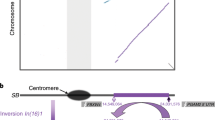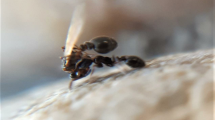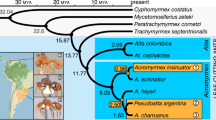Abstract
Intraspecific variability in social organization is common, yet the underlying causes are rarely known1,2,3. In the fire ant Solenopsis invicta, the existence of two divergent forms of social organization is under the control of a single Mendelian genomic element marked by two variants of an odorant-binding protein gene4,5,6,7,8. Here we characterize the genomic region responsible for this important social polymorphism, and show that it is part of a pair of heteromorphic chromosomes that have many of the key properties of sex chromosomes. The two variants, hereafter referred to as the social B and social b (SB and Sb) chromosomes, are characterized by a large region of approximately 13 megabases (55% of the chromosome) in which recombination is completely suppressed between SB and Sb. Recombination seems to occur normally between the SB chromosomes but not between Sb chromosomes because Sb/Sb individuals are non-viable. Genomic comparisons revealed limited differentiation between SB and Sb, and the vast majority of the 616 genes identified in the non-recombining region are present in the two variants. The lack of recombination over more than half of the two heteromorphic social chromosomes can be explained by at least one large inversion of around 9 megabases, and this absence of recombination has led to the accumulation of deleterious mutations, including repetitive elements in the non-recombining region of Sb compared with the homologous region of SB. Importantly, most of the genes with demonstrated expression differences between individuals of the two social forms reside in the non-recombining region. These findings highlight how genomic rearrangements can maintain divergent adaptive social phenotypes involving many genes acting together by locally limiting recombination.
This is a preview of subscription content, access via your institution
Access options
Subscribe to this journal
Receive 51 print issues and online access
$199.00 per year
only $3.90 per issue
Buy this article
- Purchase on Springer Link
- Instant access to full article PDF
Prices may be subject to local taxes which are calculated during checkout



Similar content being viewed by others
Accession codes
Primary accessions
Gene Expression Omnibus
Sequence Read Archive
Data deposits
The microarray expression data are available at the NCBI Gene Expression Omnibus (accessions GSM1031731–GSM1031746, GSM1031779–GSM1031794, GSM1040938–GSM1040947, GSM1049807–GSM1049816 and GSM1049903–GSM1049912); sequence data are available at the NCBI Sequence Read Archive (accessions SRA061944, SRP017299, SRP017317 and SRP017322).
References
Bourke, A. & Franks, N. Social Evolution in Ants (Princeton University Press, 1995)
Keller, L. Social life – the paradox of multiple-queen colonies. Trends Ecol. Evol. 10, 355–360 (1995)
Robinson, G. E., Fernald, R. D. & Clayton, D. F. Genes and social behavior. Science 322, 896–900 (2008)
Krieger, M. J. B. & Ross, K. G. Identification of a major gene regulating complex social behavior. Science 295, 328–332 (2002)
Keller, L. & Ross, K. G. Phenotypic basis of reproductive success in a social insect: genetic and social determinants. Science 260, 1107–1110 (1993)
DeHeer, C. J., Goodisman, M. A. D. & Ross, K. G. Queen dispersal strategies in the multiple-queen form of the fire ant Solenopsis invicta. Am. Nat. 153, 660–675 (1999)
Keller, L. & Ross, K. G. Selfish genes: a green beard in the red fire ant. Nature 394, 573–575 (1998)
Ross, K. G. & Keller, L. Genetic control of social organization in an ant. Proc. Natl Acad. Sci. USA 95, 14232–14237 (1998)
Ross, K. G. & Keller, L. Ecology and evolution of social-organization: insights from fire ants and other highly eusocial insects. Annu. Rev. Ecol. Syst. 26, 631–656 (1995)
Keller, L. & Ross, K. G. Major gene effects on phenotype and fitness: the relative roles of Pgm-3 and Gp-9 in introduced populations of the fire ant Solenopsis invicta. J. Evol. Biol. 12, 672–680 (1999)
Keller, L. & Ross, K. G. Gene by environment interaction: effects of a single-gene and social-environment on reproductive phenotypes of Fire Ant queens. Funct. Ecol. 9, 667–676 (1995)
Lawson, L. P., Vander Meer, R. K. & Shoemaker, D. Male reproductive fitness and queen polyandry are linked to variation in the supergene Gp-9 in the fire ant Solenopsis invicta. Proc. R. Soc. Lond. B 279, 3217–3222 (2012)
Krieger, M. J. B. & Ross, K. G. Molecular evolutionary analyses of the odorant-binding protein gene Gp-9 in fire ants and other Solenopsis species. Mol. Biol. Evol. 22, 2090–2103 (2005)
Gotzek, D. & Ross, K. G. Genetic regulation of colony social organization in fire ants: an integrative overview. Q. Rev. Biol. 82, 201–226 (2007)
Mather, K. The genetical architecture of heterostyly in Primula sinensis. Evolution 4, 340–352 (1950)
Clarke, C. A., Sheppard, P. M. & Thornton, I. W. The genetics of the mimetic butterfly Papilio memnon L. Philos. Trans. R. Soc. Lond. B 254, 37–89 (1968)
Joron, M. et al. Chromosomal rearrangements maintain a polymorphic supergene controlling butterfly mimicry. Nature 477, 203–206 (2011)
Baird, N. A. et al. Rapid SNP discovery and genetic mapping using sequenced RAD markers. PLoS ONE 3, e3376 (2008)
Glancey, B. M., Romain, M. K. S. & Crozier, R. H. Chromosome numbers of red and black imported fire ants, Solenopsis invicta and Solenopsis richteri. Ann. Entomol. Soc. Am. 69, 469–470 (1976)
Wurm, Y. et al. The genome of the fire ant Solenopsis invicta. Proc. Natl Acad. Sci. USA 108, 5679–5684 (2011)
Bachtrog, D. et al. Are all sex chromosomes created equal? Trends Genet. 27, 350–357 (2011)
Blomquist, G. J. & Vogt, R. G. Insect Pheromone Biochemistry and Molecular Biology: the Biosynthesis and Detection of Pheromones and Plant Volatiles (Academic, 2003)
Charlesworth, B. & Charlesworth, D. Elements of Evolutionary Genetics (Roberts & Company, 2010)
Bergero, R. & Charlesworth, D. Preservation of the Y transcriptome in a 10-million-year-old plant sex chromosome system. Curr. Biol. 21, 1470–1474 (2011)
Wang, J., Ross, K. G. & Keller, L. Genome-wide expression patterns and the genetic architecture of a fundamental social trait. PLoS Genet. 4, e1000127 (2008)
Yang, Z. & Bielawski, J. P. Statistical methods for detecting molecular adaptation. Trends Ecol. Evol. 15, 496–503 (2000)
Feldman, M. W. & Liberman, U. An evolutionary reduction principle for genetic modifiers. Proc. Natl Acad. Sci. USA 83, 4824–4827 (1986)
Correns, C. Die Rolle der männlichen Keimzellen bei der Geschlechtsbestimmung der gynodiöecischen Pflanzen. Ber. Deut. Bot. Ges. 26A, 686–701 (1908)
Bachtrog, D. Expression profile of a degenerating neo-Y chromosome in Drosophila. Curr. Biol. 16, 1694–1699 (2006)
Nygaard, S. et al. The genome of the leaf-cutting ant Acromyrmex echinatior suggests key adaptations to advanced social life and fungus farming. Genome Res. 21, 1339–1348 (2011)
Acknowledgements
We thank C. Stoffel, C. La Mendola, N.-C. Chang, C.-Y. Kao and C.-C. Lee for helping with genotyping and molecular biology; the DEE-UNIL animal caretakers for ant husbandry; E. Johnson and P. Etter for RADseq advice; R. Nichols, J. Meunier and R. Verity for statistical advice; K. Harshman and M.-Y. Lu for Illumina sequencing support; R. Wang for FISH support; and B. Charlesworth, D. Charlesworth, H. Kaessmann, L. Ometto, J. Pannel, N. Perrin, M. Reuter, P. Reymond and K. Ross for comments. Some computations were performed at the Vital-IT (http://www.vital-it.ch) Center for high-performance computing (HPC) of the SIB Swiss Institute of Bioinformatics and the EPSRC-funded MidPlus HPC centre. This work was supported by the Biodiversity Research Center (Academia Sinica, Taiwan), Taiwan NSC grant 100-2311-B-001-015-MY3, grants from NERC and the BBSRC (BB/K004204/1), a USDA grant, several grants from the Swiss NSF and an ERC Advanced Grant.
Author information
Authors and Affiliations
Contributions
J.W., Y.W. and L.K. designed the study and contributed to all stages of the project. M.N., D.D.S. and J.W. prepared samples. J.W. performed RAD sequencing, and J.W. and Y.W. performed genetic analyses. M.N. performed microarray experiments and analysed the data. O.R.-G. and Y.W. analysed RNA-seq and SNP data. J.W. and Y.W. analysed chromosomal locations of differentially expressed genes. Y.W. performed sequence assembly, genome comparisons, and molecular evolution analyses. Y.-C.H. performed FISH experiments. L.K., Y.W. and J.W. wrote the paper with input from other authors.
Corresponding authors
Ethics declarations
Competing interests
The authors declare no competing financial interests.
Supplementary information
Supplementary Information
This file contains Supplementary Methods and additional analysis, Supplementary References, Supplementary Figures 1-12 and Supplementary Tables 1-6. (PDF 1383 kb)
Supplementary Data
This zipped file contains Supplementary Tables 7-15. (ZIP 296 kb)
Rights and permissions
About this article
Cite this article
Wang, J., Wurm, Y., Nipitwattanaphon, M. et al. A Y-like social chromosome causes alternative colony organization in fire ants. Nature 493, 664–668 (2013). https://doi.org/10.1038/nature11832
Received:
Accepted:
Published:
Issue Date:
DOI: https://doi.org/10.1038/nature11832
This article is cited by
-
Inversions maintain differences between migratory phenotypes of a songbird
Nature Communications (2023)
-
A novel distribution of supergene genotypes is present in the socially polymorphic ant Formica neoclara
BMC Ecology and Evolution (2022)
-
Recurring adaptive introgression of a supergene variant that determines social organization
Nature Communications (2022)
-
Colonization by the Red Imported Fire Ant, Solenopsis invicta, Modifies Soil Bacterial Communities
Microbial Ecology (2022)
-
Characterization of Queen Supergene Pheromone in the Red Imported Fire Ant Using Worker Discrimination Assays
Journal of Chemical Ecology (2022)
Comments
By submitting a comment you agree to abide by our Terms and Community Guidelines. If you find something abusive or that does not comply with our terms or guidelines please flag it as inappropriate.



